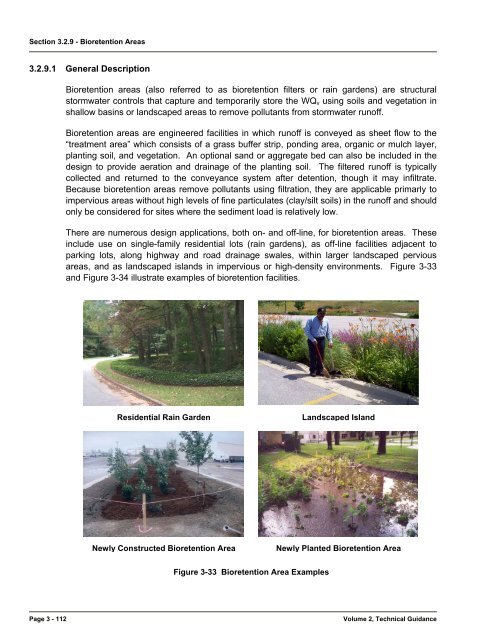Volume 2-05, Chapter 3 - City of Wichita
Volume 2-05, Chapter 3 - City of Wichita
Volume 2-05, Chapter 3 - City of Wichita
Create successful ePaper yourself
Turn your PDF publications into a flip-book with our unique Google optimized e-Paper software.
Section 3.2.9 - Bioretention Areas<br />
3.2.9.1 General Description<br />
Bioretention areas (also referred to as bioretention filters or rain gardens) are structural<br />
stormwater controls that capture and temporarily store the WQ v using soils and vegetation in<br />
shallow basins or landscaped areas to remove pollutants from stormwater run<strong>of</strong>f.<br />
Bioretention areas are engineered facilities in which run<strong>of</strong>f is conveyed as sheet flow to the<br />
“treatment area” which consists <strong>of</strong> a grass buffer strip, ponding area, organic or mulch layer,<br />
planting soil, and vegetation. An optional sand or aggregate bed can also be included in the<br />
design to provide aeration and drainage <strong>of</strong> the planting soil. The filtered run<strong>of</strong>f is typically<br />
collected and returned to the conveyance system after detention, though it may infiltrate.<br />
Because bioretention areas remove pollutants using filtration, they are applicable primarly to<br />
impervious areas without high levels <strong>of</strong> fine particulates (clay/silt soils) in the run<strong>of</strong>f and should<br />
only be considered for sites where the sediment load is relatively low.<br />
There are numerous design applications, both on- and <strong>of</strong>f-line, for bioretention areas. These<br />
include use on single-family residential lots (rain gardens), as <strong>of</strong>f-line facilities adjacent to<br />
parking lots, along highway and road drainage swales, within larger landscaped pervious<br />
areas, and as landscaped islands in impervious or high-density environments. Figure 3-33<br />
and Figure 3-34 illustrate examples <strong>of</strong> bioretention facilities.<br />
Residential Rain Garden<br />
Landscaped Island<br />
Newly Constructed Bioretention Area<br />
Newly Planted Bioretention Area<br />
Figure 3-33 Bioretention Area Examples<br />
Page 3 - 112<br />
<strong>Volume</strong> 2, Technical Guidance
















